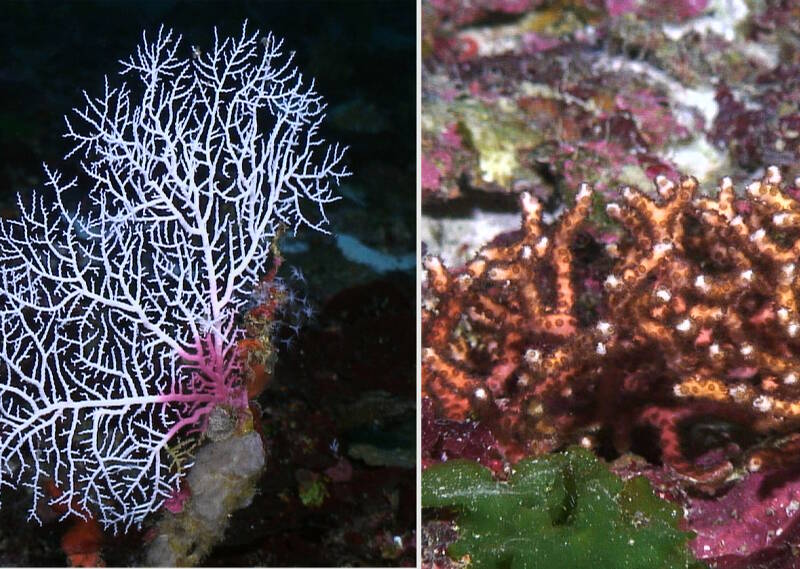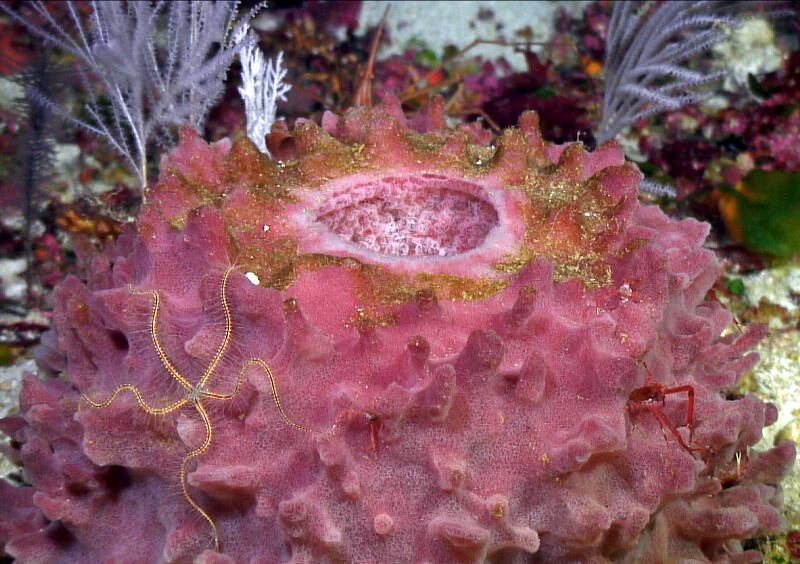
By John Reed, Florida Atlantic University-Harbor Branch
August 21, 2014
Ambushing Lionfish sometimes use gorgonians to camouflage themselves from their prey. Video courtesy of Coral Ecosystem Connectivity 2014 Expedition. Download (mp4, 1.8 MB)
This is the third year of our project on Pulley Ridge using remotely operated vehicles (ROVs) to characterize these deep-water reefs. Most reefs familiar to us are shallow (found at depths of 10 to 100 feet), like reefs in the Florida Keys or Bahamas. However, Pulley Ridge is a mesophotic reef, which is much deeper (194 to 344 feet) and at the lower depth limit for many of the plants and animals living here. At this depth, there is barely enough sunlight to support the growth of algae and the corals that have symbiotic algae in their tissues.

The top of West Pulley Ridge outside the Habitat Area of Particular Concern reveals a high diversity of plants and animals including dozens of sponges, lettuce algae (Anadyomene) far left, crustose coralline algae encrusting the rocks, sea whips (Ellisella) and black fan corals (Antipathes). Image courtesy of Coral Ecosystem Connectivity 2014 Expedition. Download larger version (jpg, 837 KB).
Today, Pulley Ridge is the deepest mesophotic reef off the continental U.S. waters and one of the most species-rich and diverse. The diversity of an ecosystem or reef refers to the variety and abundance of organisms that live there. Some of the most diverse ecosystems on earth are the Amazon jungles and coral reefs. We are just now beginning to study these deeper mesophotic reefs to understand their connection to shallower reefs. Some indications suggest that they may act as refugia for species of corals and fish that are stressed or dying in shallow water due to global warming, disease, fishing pressure, and sedimentation from dredging and clear cutting. Mesophotic reefs are located in deeper, cooler water further offshore, and so may be less impacted by these factors and allow some species to survive.

Examples of corals commonly found on Pulley Ridge. At left is the hydrocoral Stylaster, at right is Madracis finger coral. The Madracis is colored brown by symbiotic algae living in its tissues. Image courtesy of Coral Ecosystem Connectivity 2014 Expedition. Download larger version (jpg, 798 KB).
Our research will be used to identify all of the large plants and animals living on Pulley Ridge. This year’s cruise is going to new sites that have never been seen before. Today and yesterday, we found some incredibly diverse reefs west of the main ridge of Pulley Ridge and some of the most coral rich sites that we have found thus far.
In the past two years, our ROV dives covered nearly 20 miles of seafloor. We have recorded over 100 hours of video and taken 7,500 digital still photos, which are used to identify and count the benthic species (corals, sponges, algae) and fish. A total of 86 fish species have been identified, including numerous small reef fish, as well as commercially - and recreationally - important grouper and snapper species such as Vermilion Snapper, Black Grouper, Mutton Snapper, Red Grouper and Scamp. In addition, we have identified a total of 136 benthic invertebrate species including 92 sponges, 17 hard corals, 9 black corals, and 18 soft corals (sea fans).

Close up of a giant barrel sponge, Xestospongia muta, which provides habitat for many creatures including a squat lobster (right) and a brittle star (left). Image courtesy of Coral Ecosystem Connectivity 2014 Expedition. Download larger version (jpg, 844 KB).
Ultimately, data from the various cruises will be used to characterize and document the habitat, benthic communities, and fish populations inside and outside the Pulley Ridge Habitat Area of Particular Concern. These data may then be compared to future research to better understand the long-term health and status of mesophotic coral ecosystems. These data will be of great value to NOAA’s Office of National Marine Sanctuaries and National Marine Fisheries Service and the regional Fishery Management Councils for making management decisions regarding these habitats and managed species.